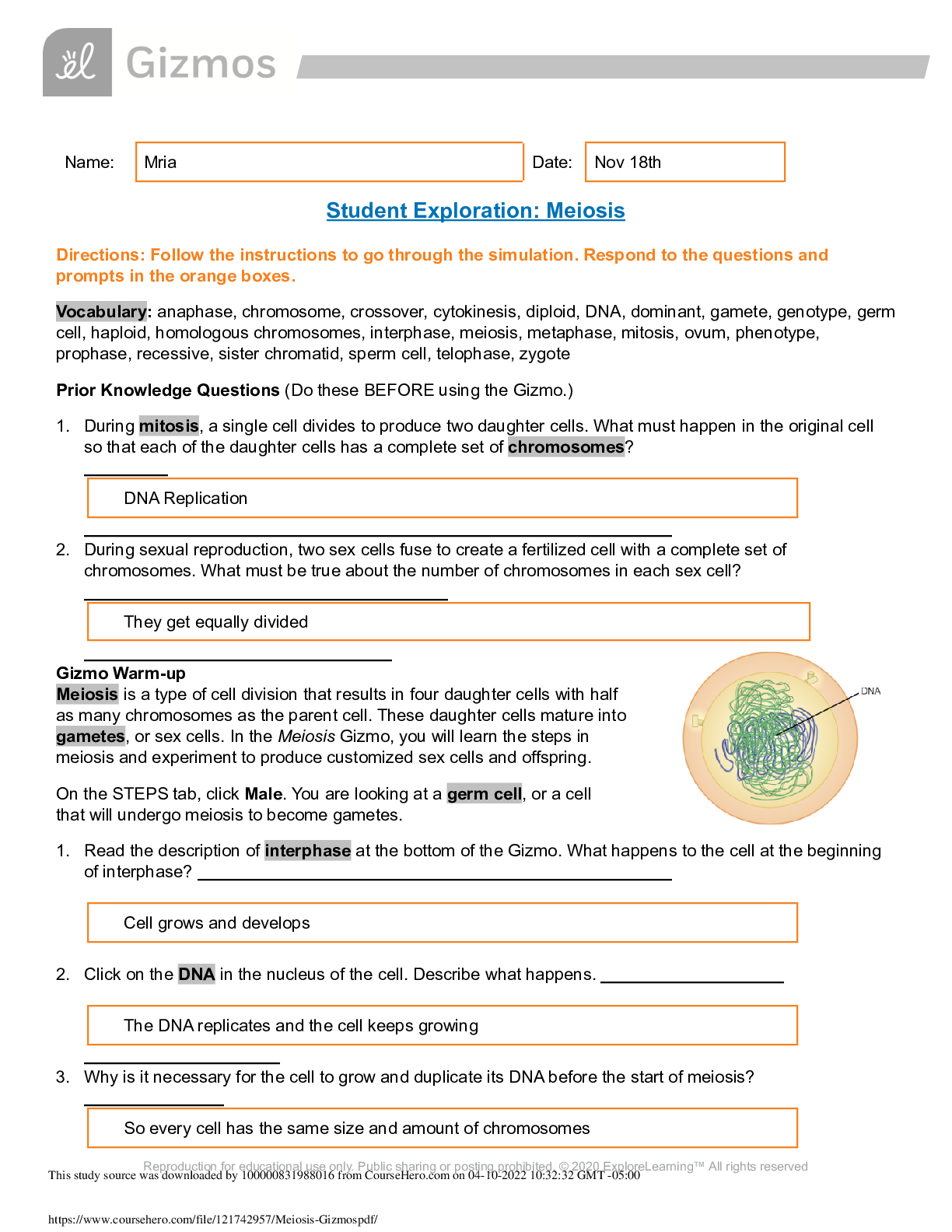Thermodynamics > GIZMOS > Energy_Conversions_Gizmos Guide to Success (All)
Energy_Conversions_Gizmos Guide to Success
Document Content and Description Below
Directions: Follow the instructions to go through the simulation. Respond to the questions and prompts in the orange boxes. Vocabulary: bacteriophage, capsid, host cell, lyse, lytic cycle, virus Pr... ior Knowledge Questions (Do these BEFORE using the Gizmo.) 1. A computer virus is a program that can copy itself and infect a computer without the permission of the owner. How do you think a computer virus compares to a real virus? Gizmo Warm-up A virus is a microscopic particle that can infect a cell. Viruses are primarily composed of a protein coat, called a capsid, and nucleic acid. In the Virus Lytic Cycle Gizmo™, you will learn how a virus infects a cell and uses the cell to produce more viruses. 1. Viruses are extremely small. A typical virus is about 100 times smaller than a single cell, such as a bacterium. Label the virus and a bacterial cell in the image at right. 2. Bacteriophages are viruses that infect bacteria. Based on the diagram at left, label the head, tail, tail fibers, and the strand of nucleic acid in the image at right. Reproduction for educational use only. Public sharing or posting prohibited. © 2020 ExploreLearning™ All rights reserved Name: Aashka Prajapati Date: 2020-11-27 similar to a computer virus, a real virus also copies the genetic information and corrupts it and sends it to other cells to corrupt those cells as well. 2. Have you ever been infected with a virus, such as the cold virus or flu virus? yes, a cold virus 3. If so, how did the virus affect you? sore throat, weakness, runny nose. Introduction: Unlike living organisms, viruses cannot reproduce on their own. Instead, viruses infect host cells, taking over the cell’s machinery to produce more viruses. This process is called the lytic cycle. Question: What are the steps of the lytic cycle? 1. 75.Observe: Use the navigation arrows on the DESCRIPTION tab to read about the stages of the lytic cycle. Using your own words, summarize each step of the cycle. Reproduction for educational use only. Public sharing or posting prohibited. © 2020 ExploreLearning™ All rights reserved Activity A: Lytic cycle Get the Gizmo ready: ● If necessary, click Reset ( ). Step Summary 1 a lytic bacteriophage virus attaches itself to the bacterial cell. virus is a simple structure that is composed of a protein capsid, nucleic acid (DNA or RNA) and a tail section ↓ 2 The virus injects its nucleic acid into the bacterial cell. The nucleic acid uses the cell’s ribosomes to make virus proteins. The proteins break up the cell’s DNA. ↓ 3 the virus capsid and tail detaches from the cell and disintegrates. the viral nucleic acid takes over and directs the production of new virus proteins and nucleic acid. ↓ 4 The virus proteins and virus nucleic acid combine together into new viruses. ↓ 5 special proteins produced by the viral nucleic acid cause the host bacterial cell enter the lytic cycle, which destroys the cell in the process. The numerous new viruses can infect other cells 2. Analyze: The yellow ring inside the bacterial cell represents the bacterial DNA. Why does this structure disappear by step 3 of the lytic cycle? 3. Describe: How does a virus destroy the host cell’s DNA? 4. Describe: How are new viruses reproduced? 5. Think and discuss: Why can’t a virus reproduce on its own? 6. Justify: To lyse is to burst apart or explode. Why do you think a virus’s reproduction cycle is called the “lytic cycle”? Reproduction for educational use only. Public sharing or posting prohibited. © 2020 ExploreLearning™ All rights reserved because the viral protein breaks the cells DNA in step 2 by creating a protein using the cells ribosomes and the viral nucleic acid Once the viral proteins are made, the virus capsid and tail disintegrate. The virus proteins and virus cells then combine together to form more viruses. a virus can’t reproduce on its own because viruses are non-living. they are just packages meant to take over the cell. A virus’s reproduction cycle is called a “cycle” because it repeats itself. After it bursts open, it enters other cells and goes through the same reproduction process it did before. Question: How does a viral infection spread? 1. Predict: Suppose that a virus infects a small population of bacteria. Predict how the numbers of viruses, infected cells, and uninfected cells will change as the infection progresses. On the blanks below, write increase, decrease, or stay the same. 2. Observe: Click Play ( ), and watch the simulation. Describe what you see. 3. Test: Click Reset, and Select the BAR CHART tab. Turn on Show numerical values. Click Play, and watch each bar as the simulation runs. What do you notice, and how does this compare to your predictions? 4. Record data: Select the TABLE tab, and use the data to complete the second column of the table below. To complete each cell in the third column, subtract the previous time value from the current time value. For example, if it took 80 minutes to reach 40 cells and 100 minutes to reach 30 cells, then the time difference is 20 minutes. Reproduction for educational use only. Public sharing or posting prohibited. © 2020 ExploreLearning™ All rights reserved Activity B: Spread of infection Get the Gizmo ready: ● If necessary, click Reset. Viruses: increase Infected cells: stay the same Uninfected cells decrease - a single virus enters the bacteria cell - it reproduces in the bacteria cell - it cell is destroyed and it bursts open releasing more virus - The viruses travel to other bacteria cells and reproduce and destroy the cell. the number of healthy cells decreases, infected cells stay the same and the number of viruses increase. my predictions were correct. - virus number increases because viruses reproduce - infected cells increase then the virus enters the cell but decrease when the virus leaves the cell because they have been destroyed - healthy cells decrease because they are no longer healthy after the virus enters it. Number of healthy cells Time (minutes) Amount of time to decrease population by 10 50 0 minutes -- 40 61 min 61 min 30 93 min 32 min 20 122min 29 min 10 150 min 28 min 9. Interpret: Select the GRAPH tab. Run the Gizmo again, and observe what happens in the SIMULATION pane when the graph shows a decrease in the viruses’ population size. 10. Extend your thinking: AIDS is one disease caused by a virus infection. The virus attacks immune system cells known as T cells. Based on your observations from the Gizmo, how would you explain the data shown on the graph? Reproduction for educational use only. Public sharing or posting prohibited. © 2020 ExploreLearning™ All rights reserved 7. Analyze: What trend do you see in the third column of your data table? the time decreases. 8. Explain: How would you explain this trend? As the number of cells goes down, the time it takes to decrease, increases A. Why does the number of viruses sometimes increase and sometimes decrease? when the virus population decreases, it could be because the virus is inside the host cell so the number of viruses inside the host cells are not counted which decreases the number of viruses. B. Sometimes when a virus enters a cell, it becomes dormant for a while. Why might this make it difficult for a doctor to diagnose a viral infection? because in its dormant state, the virus is inactive and the person will have no symptoms, which makes the cell appear to be healthy [Show More]
Last updated: 1 year ago
Preview 1 out of 5 pages
Instant download

Instant download
Reviews( 0 )
Document information
Connected school, study & course
About the document
Uploaded On
Jul 07, 2021
Number of pages
5
Written in
Additional information
This document has been written for:
Uploaded
Jul 07, 2021
Downloads
0
Views
82










.png)
























.png)

